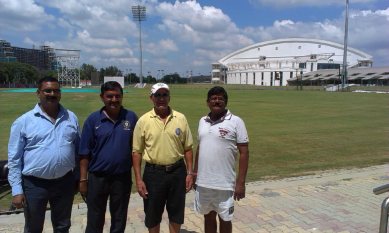Stay updated with the latest sports news across Cricket, Football, Chess, and more. Catch all the action with real-time live cricket score updates and in-depth coverage of ongoing matches.
Duleep Trophy 2016: Pink ball under the scanner yet again
Greater Noida Stadium gets ready to host first day and night Duleep Trophy tournament.

Snake past a couple of traffic roundabouts at the end of the six-lane Noida-Greater Noida Expressway and drive past a resort to reach the Shahid Vijay Singh Pathik Sports Complex. All around the complex, and even along the way, there are half-finished high-rise buildings, reminder of NCR’s realty downturn. Close by there is an under-construction metro station, a selling point that features in every construction-company brochures that are being hawked from makeshift kiosks in the area.
Once inside the gates, the smell of freshly-painted walls wafts through the air, housecleaning staff is working overtime, chrome-finish fittings are being polished and electricians are checking the wiring. If this was a sample flat, it would have sold.
monthly limit of free stories.
with an Express account.
In a way it is. BCCI too is trying to sell an idea — ‘days cricket’ at night. For about a month, perspective buyers —players and fans — will be visiting this Greater Noida venue.
On Tuesday, Duleep Trophy, dumped out of the choc-a-block calendar last year, will makes its return in a day-night format. Central to the success of the day-night games, stretched to an unearthly hour of 9 pm for a four-day match, will be how the pink cricket ball, the Kookaburra, fares.
It will be a tough test for the ‘pink ball’ as it needs to tick a few mandatory boxes. For this concept to succeed, the pink ball should last for 80 overs, which means it should not go out of shape and should also be visible to players, especially the batsmen and fielders on the fence.
Experts are also keen to see how much the assistance spinners will get. If the slow bowlers don’t warm up to the new ball or find difficulty gripping the seam (Kookaburra had stitched in a pronounced seam for the ball used during the club match conducted at the Eden Gardens in June), it would mean loss of the home advantage when hosting a pink-ball Test during a home season.
For starters, the ball must go the distance and that is where the expertise of Daljit Singh, the pitch and ground committee chairman of the BCCI comes in. Singh is an old hand in the art and science of preparing a cricket pitch and outfield.
He should leave more than the usual amount of grass on the outfield and on the pitch to protect the ball from getting soiled or rapidly losing colour, which will make it difficult for players to the sight it. At the Adelaide Oval, the venue of the first day-night Test, and at the Eden Gardens, where the club match was played, the outfield and the pitch were greener than the regular Test match wicket.
On Sunday, Singh and his team of curators comprising Central Zone’s Taposh Chatterjee and one from Meerut and another from Kanpur, were readying for the experiment ahead. For all his experience the curator wasn’t going to wager on how the pink-ball would come out after 80 overs of play.
“Nobody is very sure of the outcome and even outside only one Test match has been played in Australia. The more we play, we will have a better idea of how the ball behaves and we will learn more. Nobody is sure about the durability of the pink ball. We presume the pitch will have to be grassy for the ball to last and the outfield will also have to be lush. It is to be seen how the players adapt to the pink ball,” Singh said before adding, “it is something new which has to be tried out and it is a bold initiative of the BCCI to try it early in the season.”
Fast forwarding the cricket calendar to August is bound to have its effects at this venue during the Duleep Trophy. The seven pitches, three of which will be used for the matches, have been unused for three months and were to be match ready only by mid-October. Because of the showers the base of the wicket has not dried up which means it should be on the slower side. The seam will grip the grass but the lack of bounce may be a factor.
Also this match won’t be played on a surface similar in nature to the one at the Adelaide Oval, where the curator had left 11mm of grass on the pitch, or the lush green Eden Gardens.
The grass on the outfield at the Greater Noida stadium is 10 mm and the wicket is likely to have 5 to 6 mm of cover. When the ball travels over the out-field it will encounter bald patches around the mid-off and mid-on area, which can hasten deterioration of the pink-ball.
But while making arm-chair predictions of how Indian cricketers’ tryst with the pink-ball under lights plays out, it is wise to take a leaf out of curator Singh’s book and follow his policy. Wait and watch.
Teams
India Red: Yuvraj Singh (Capt), Abhinav Mukund, KS Bharat, Sudip Chatterjee Gurkeerat Singh, Ankush Bains (WK), Arun Karthik, Akshay Wakhare, Kuldeep Yadav, Nathu Singh, Anureet Singh, Ishwar Pandey, Nitish Rana, M Ashwin, Abhimanyu Mithun
India Blue: Gautam Gambhir (Capt), Mayank Agarwal, Sheldon Jackson, Baba Aparajith, Siddhesh Lad, Dinesh Karthik (WK), Parvez Rasool, K Monish, Krishna Das, Suryakumar Yadav, Mohit Sharma, Pankaj Singh, Shardul Thakur, Cheteshwar Pujara, Hanuma Vihari
India Green: Suresh Raina (Capt), Robin Uthappa, Jalaj Saxena, Ambati Rayudu, Ian Dev Singh, Rohan Prem, Parthiv Patel (WK), Shreyas Gopal, Ashoke Dinda, Sandeep Sharma, Ankit Rajpoot, Rajat Paliwal, Jasprit Bumrah, Murali Vijay